Strategic HRM Practices and Organisational Culture Analysis Report
VerifiedAdded on 2022/09/18
|17
|5459
|19
Report
AI Summary
This report examines the HRM practices of Company X, an Australian supermarket, focusing on their alignment with organizational culture and strategic goals. The report begins with an introduction to the company, its operations, and the methodology used, including both primary and secondary research methods like interviews and analysis of company documents. A comprehensive literature review explores the meaning of organizational culture, its different types (Clan, Adhocracy, Market, and Hierarchy), and its impact on organizational performance. The report then delves into the HRM practices of Company X, including recruitment, selection, induction, training and development, performance appraisal, and recognition and reward systems. Each practice is analyzed to determine its effectiveness in building and maintaining the desired organizational culture, as well as its impact on employee engagement and overall company performance. The report concludes with recommendations for improvement and a summary of the findings, emphasizing the importance of aligning HRM practices with the company's strategic objectives to enhance employee experience and drive organizational success. The report highlights the importance of transparency, employee well-being, and a customer-centric approach within Company X's HRM strategy.
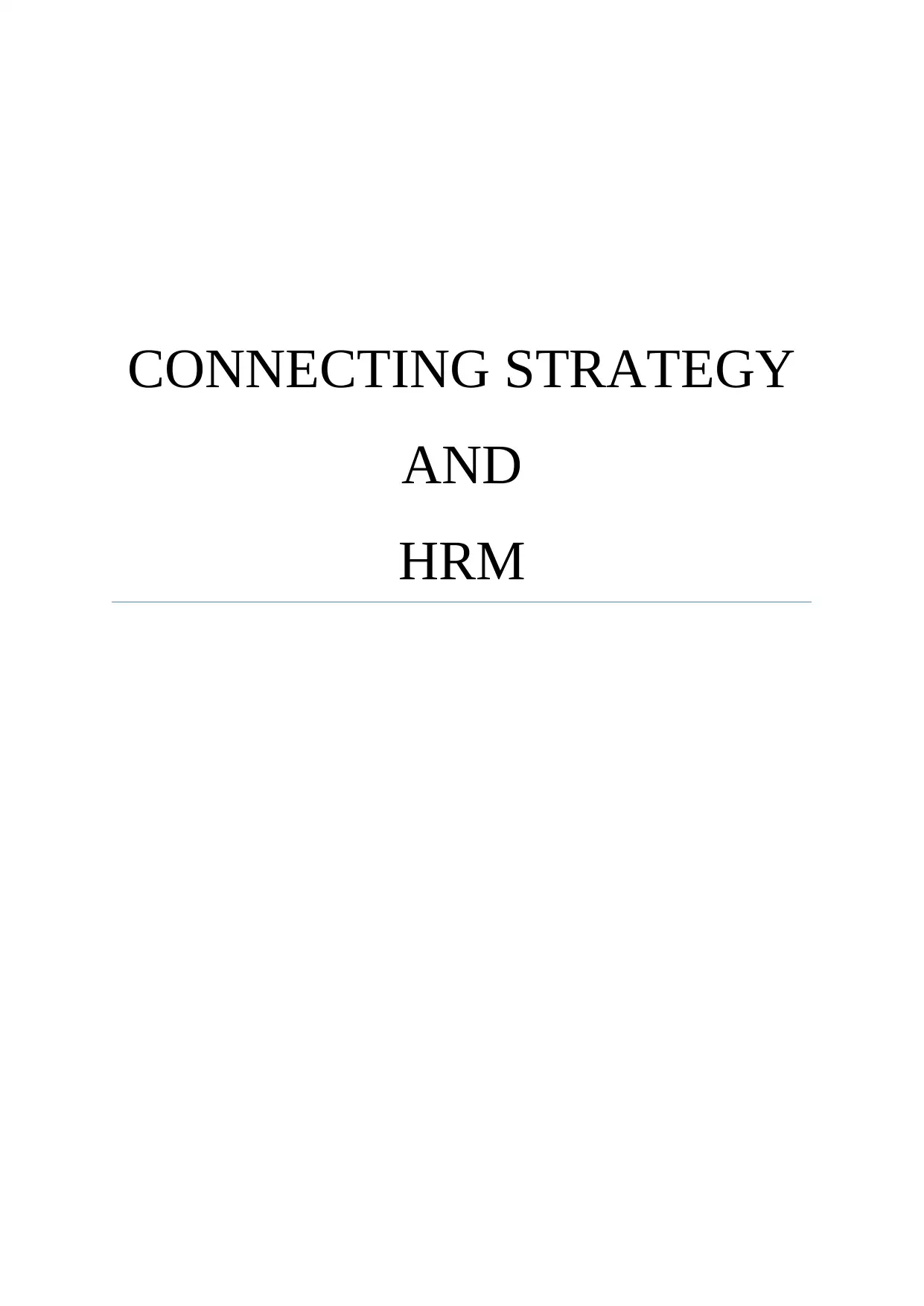
CONNECTING STRATEGY
AND
HRM
AND
HRM
Paraphrase This Document
Need a fresh take? Get an instant paraphrase of this document with our AI Paraphraser
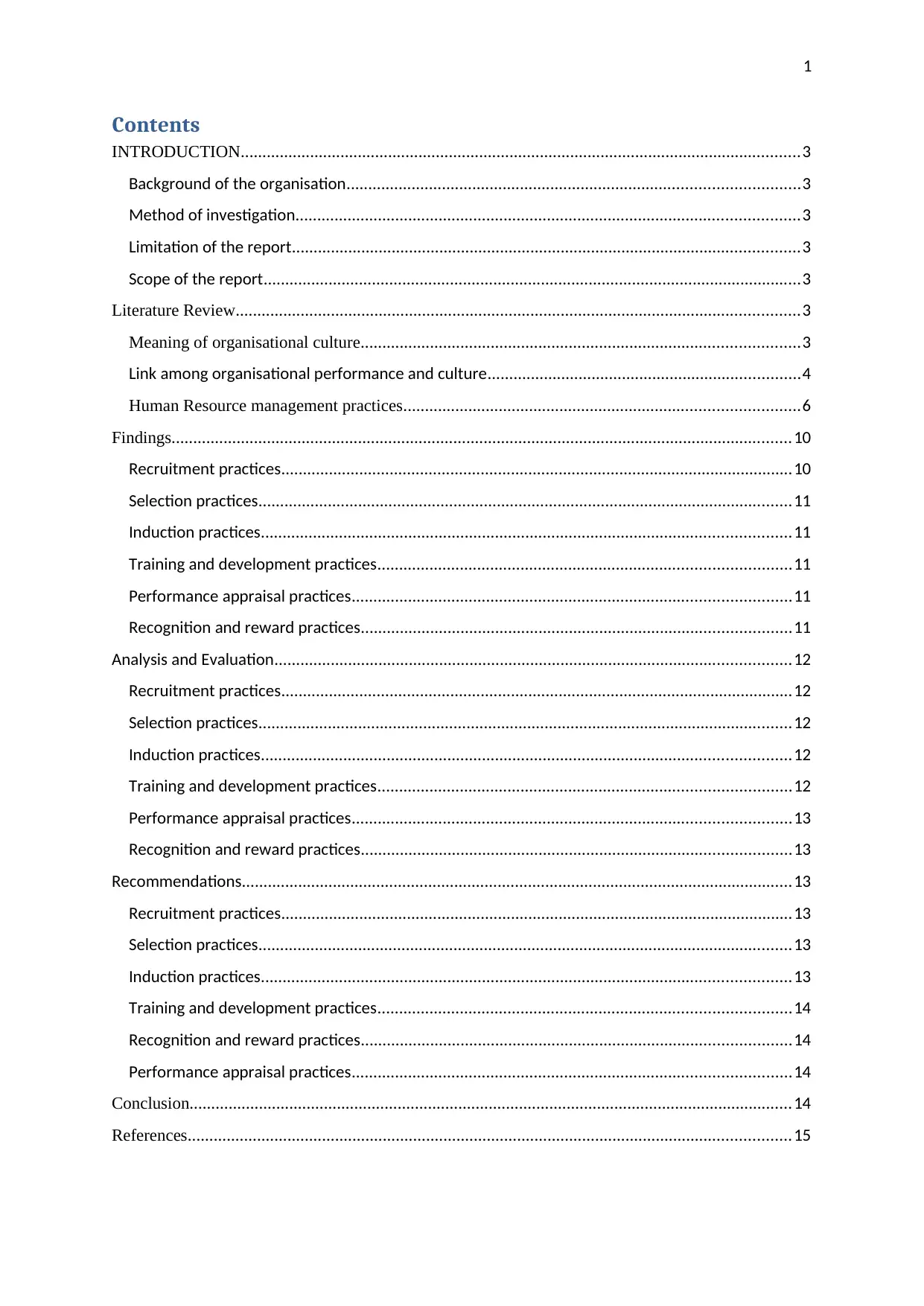
1
Contents
INTRODUCTION.................................................................................................................................3
Background of the organisation........................................................................................................3
Method of investigation....................................................................................................................3
Limitation of the report.....................................................................................................................3
Scope of the report............................................................................................................................3
Literature Review..................................................................................................................................3
Meaning of organisational culture.....................................................................................................3
Link among organisational performance and culture........................................................................4
Human Resource management practices...........................................................................................6
Findings...............................................................................................................................................10
Recruitment practices......................................................................................................................10
Selection practices...........................................................................................................................11
Induction practices..........................................................................................................................11
Training and development practices...............................................................................................11
Performance appraisal practices.....................................................................................................11
Recognition and reward practices...................................................................................................11
Analysis and Evaluation.......................................................................................................................12
Recruitment practices......................................................................................................................12
Selection practices...........................................................................................................................12
Induction practices..........................................................................................................................12
Training and development practices...............................................................................................12
Performance appraisal practices.....................................................................................................13
Recognition and reward practices...................................................................................................13
Recommendations...............................................................................................................................13
Recruitment practices......................................................................................................................13
Selection practices...........................................................................................................................13
Induction practices..........................................................................................................................13
Training and development practices...............................................................................................14
Recognition and reward practices...................................................................................................14
Performance appraisal practices.....................................................................................................14
Conclusion...........................................................................................................................................14
References...........................................................................................................................................15
Contents
INTRODUCTION.................................................................................................................................3
Background of the organisation........................................................................................................3
Method of investigation....................................................................................................................3
Limitation of the report.....................................................................................................................3
Scope of the report............................................................................................................................3
Literature Review..................................................................................................................................3
Meaning of organisational culture.....................................................................................................3
Link among organisational performance and culture........................................................................4
Human Resource management practices...........................................................................................6
Findings...............................................................................................................................................10
Recruitment practices......................................................................................................................10
Selection practices...........................................................................................................................11
Induction practices..........................................................................................................................11
Training and development practices...............................................................................................11
Performance appraisal practices.....................................................................................................11
Recognition and reward practices...................................................................................................11
Analysis and Evaluation.......................................................................................................................12
Recruitment practices......................................................................................................................12
Selection practices...........................................................................................................................12
Induction practices..........................................................................................................................12
Training and development practices...............................................................................................12
Performance appraisal practices.....................................................................................................13
Recognition and reward practices...................................................................................................13
Recommendations...............................................................................................................................13
Recruitment practices......................................................................................................................13
Selection practices...........................................................................................................................13
Induction practices..........................................................................................................................13
Training and development practices...............................................................................................14
Recognition and reward practices...................................................................................................14
Performance appraisal practices.....................................................................................................14
Conclusion...........................................................................................................................................14
References...........................................................................................................................................15

2
⊘ This is a preview!⊘
Do you want full access?
Subscribe today to unlock all pages.

Trusted by 1+ million students worldwide
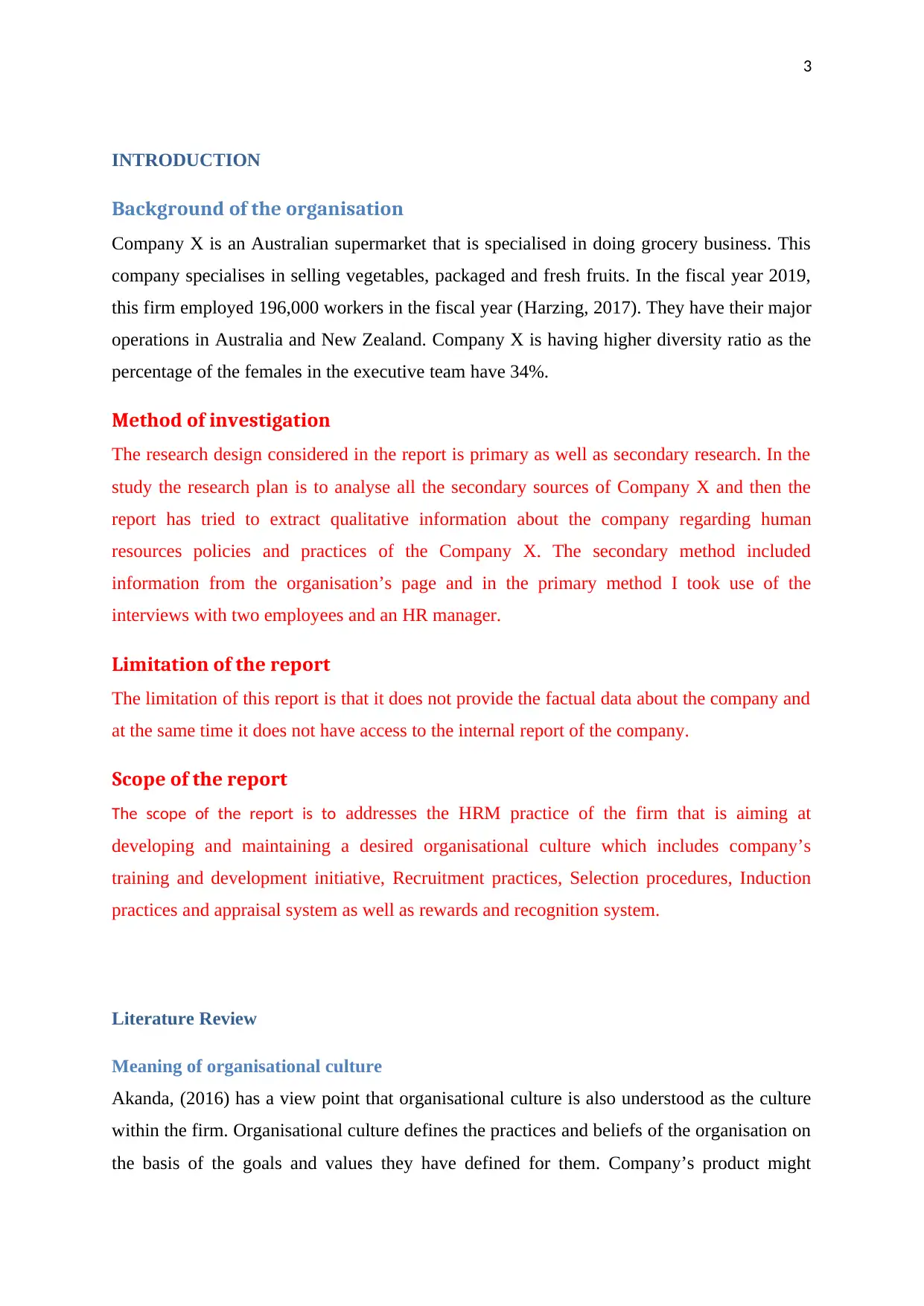
3
INTRODUCTION
Background of the organisation
Company X is an Australian supermarket that is specialised in doing grocery business. This
company specialises in selling vegetables, packaged and fresh fruits. In the fiscal year 2019,
this firm employed 196,000 workers in the fiscal year (Harzing, 2017). They have their major
operations in Australia and New Zealand. Company X is having higher diversity ratio as the
percentage of the females in the executive team have 34%.
Method of investigation
The research design considered in the report is primary as well as secondary research. In the
study the research plan is to analyse all the secondary sources of Company X and then the
report has tried to extract qualitative information about the company regarding human
resources policies and practices of the Company X. The secondary method included
information from the organisation’s page and in the primary method I took use of the
interviews with two employees and an HR manager.
Limitation of the report
The limitation of this report is that it does not provide the factual data about the company and
at the same time it does not have access to the internal report of the company.
Scope of the report
The scope of the report is to addresses the HRM practice of the firm that is aiming at
developing and maintaining a desired organisational culture which includes company’s
training and development initiative, Recruitment practices, Selection procedures, Induction
practices and appraisal system as well as rewards and recognition system.
Literature Review
Meaning of organisational culture
Akanda, (2016) has a view point that organisational culture is also understood as the culture
within the firm. Organisational culture defines the practices and beliefs of the organisation on
the basis of the goals and values they have defined for them. Company’s product might
INTRODUCTION
Background of the organisation
Company X is an Australian supermarket that is specialised in doing grocery business. This
company specialises in selling vegetables, packaged and fresh fruits. In the fiscal year 2019,
this firm employed 196,000 workers in the fiscal year (Harzing, 2017). They have their major
operations in Australia and New Zealand. Company X is having higher diversity ratio as the
percentage of the females in the executive team have 34%.
Method of investigation
The research design considered in the report is primary as well as secondary research. In the
study the research plan is to analyse all the secondary sources of Company X and then the
report has tried to extract qualitative information about the company regarding human
resources policies and practices of the Company X. The secondary method included
information from the organisation’s page and in the primary method I took use of the
interviews with two employees and an HR manager.
Limitation of the report
The limitation of this report is that it does not provide the factual data about the company and
at the same time it does not have access to the internal report of the company.
Scope of the report
The scope of the report is to addresses the HRM practice of the firm that is aiming at
developing and maintaining a desired organisational culture which includes company’s
training and development initiative, Recruitment practices, Selection procedures, Induction
practices and appraisal system as well as rewards and recognition system.
Literature Review
Meaning of organisational culture
Akanda, (2016) has a view point that organisational culture is also understood as the culture
within the firm. Organisational culture defines the practices and beliefs of the organisation on
the basis of the goals and values they have defined for them. Company’s product might
Paraphrase This Document
Need a fresh take? Get an instant paraphrase of this document with our AI Paraphraser
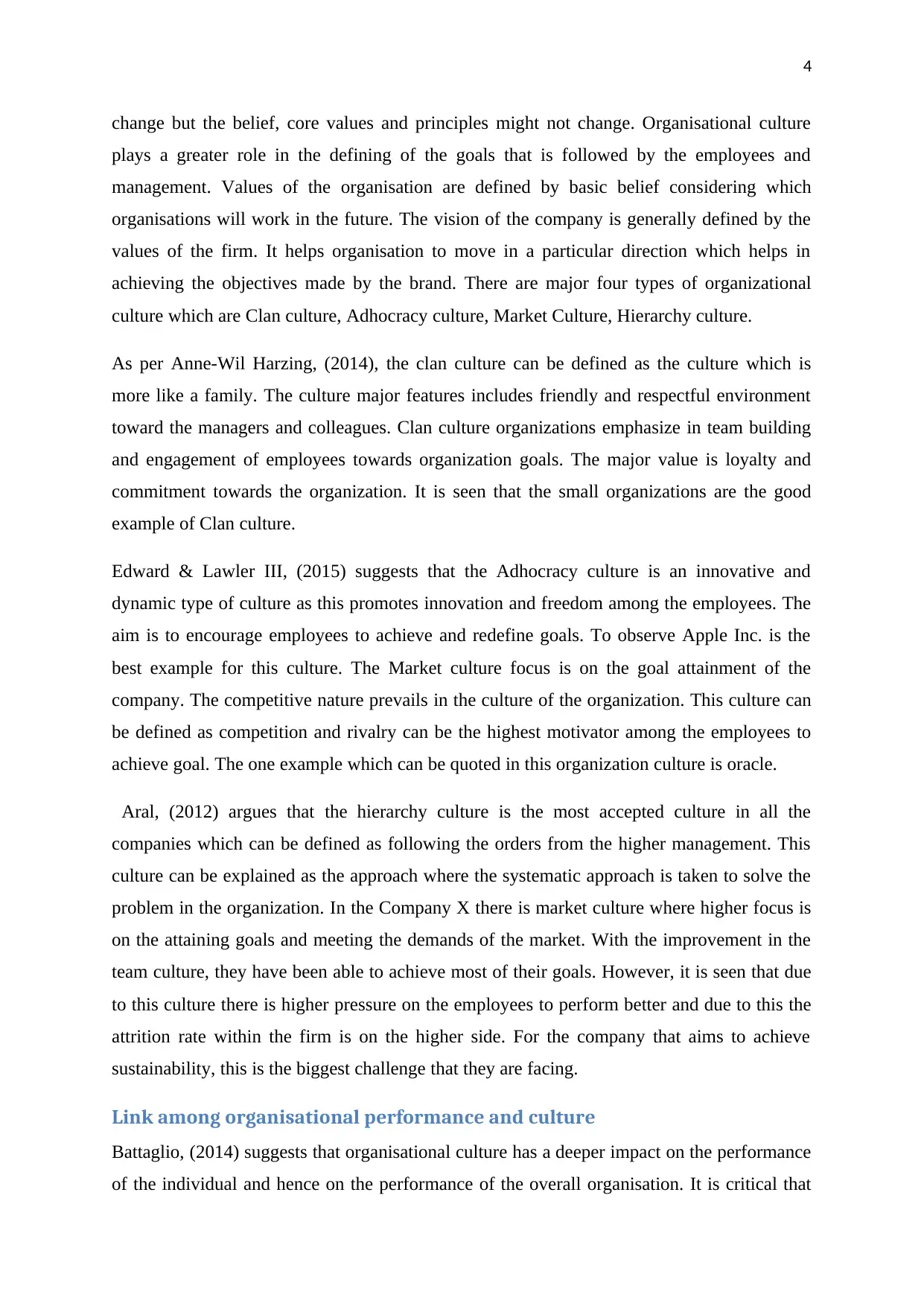
4
change but the belief, core values and principles might not change. Organisational culture
plays a greater role in the defining of the goals that is followed by the employees and
management. Values of the organisation are defined by basic belief considering which
organisations will work in the future. The vision of the company is generally defined by the
values of the firm. It helps organisation to move in a particular direction which helps in
achieving the objectives made by the brand. There are major four types of organizational
culture which are Clan culture, Adhocracy culture, Market Culture, Hierarchy culture.
As per Anne-Wil Harzing, (2014), the clan culture can be defined as the culture which is
more like a family. The culture major features includes friendly and respectful environment
toward the managers and colleagues. Clan culture organizations emphasize in team building
and engagement of employees towards organization goals. The major value is loyalty and
commitment towards the organization. It is seen that the small organizations are the good
example of Clan culture.
Edward & Lawler III, (2015) suggests that the Adhocracy culture is an innovative and
dynamic type of culture as this promotes innovation and freedom among the employees. The
aim is to encourage employees to achieve and redefine goals. To observe Apple Inc. is the
best example for this culture. The Market culture focus is on the goal attainment of the
company. The competitive nature prevails in the culture of the organization. This culture can
be defined as competition and rivalry can be the highest motivator among the employees to
achieve goal. The one example which can be quoted in this organization culture is oracle.
Aral, (2012) argues that the hierarchy culture is the most accepted culture in all the
companies which can be defined as following the orders from the higher management. This
culture can be explained as the approach where the systematic approach is taken to solve the
problem in the organization. In the Company X there is market culture where higher focus is
on the attaining goals and meeting the demands of the market. With the improvement in the
team culture, they have been able to achieve most of their goals. However, it is seen that due
to this culture there is higher pressure on the employees to perform better and due to this the
attrition rate within the firm is on the higher side. For the company that aims to achieve
sustainability, this is the biggest challenge that they are facing.
Link among organisational performance and culture
Battaglio, (2014) suggests that organisational culture has a deeper impact on the performance
of the individual and hence on the performance of the overall organisation. It is critical that
change but the belief, core values and principles might not change. Organisational culture
plays a greater role in the defining of the goals that is followed by the employees and
management. Values of the organisation are defined by basic belief considering which
organisations will work in the future. The vision of the company is generally defined by the
values of the firm. It helps organisation to move in a particular direction which helps in
achieving the objectives made by the brand. There are major four types of organizational
culture which are Clan culture, Adhocracy culture, Market Culture, Hierarchy culture.
As per Anne-Wil Harzing, (2014), the clan culture can be defined as the culture which is
more like a family. The culture major features includes friendly and respectful environment
toward the managers and colleagues. Clan culture organizations emphasize in team building
and engagement of employees towards organization goals. The major value is loyalty and
commitment towards the organization. It is seen that the small organizations are the good
example of Clan culture.
Edward & Lawler III, (2015) suggests that the Adhocracy culture is an innovative and
dynamic type of culture as this promotes innovation and freedom among the employees. The
aim is to encourage employees to achieve and redefine goals. To observe Apple Inc. is the
best example for this culture. The Market culture focus is on the goal attainment of the
company. The competitive nature prevails in the culture of the organization. This culture can
be defined as competition and rivalry can be the highest motivator among the employees to
achieve goal. The one example which can be quoted in this organization culture is oracle.
Aral, (2012) argues that the hierarchy culture is the most accepted culture in all the
companies which can be defined as following the orders from the higher management. This
culture can be explained as the approach where the systematic approach is taken to solve the
problem in the organization. In the Company X there is market culture where higher focus is
on the attaining goals and meeting the demands of the market. With the improvement in the
team culture, they have been able to achieve most of their goals. However, it is seen that due
to this culture there is higher pressure on the employees to perform better and due to this the
attrition rate within the firm is on the higher side. For the company that aims to achieve
sustainability, this is the biggest challenge that they are facing.
Link among organisational performance and culture
Battaglio, (2014) suggests that organisational culture has a deeper impact on the performance
of the individual and hence on the performance of the overall organisation. It is critical that
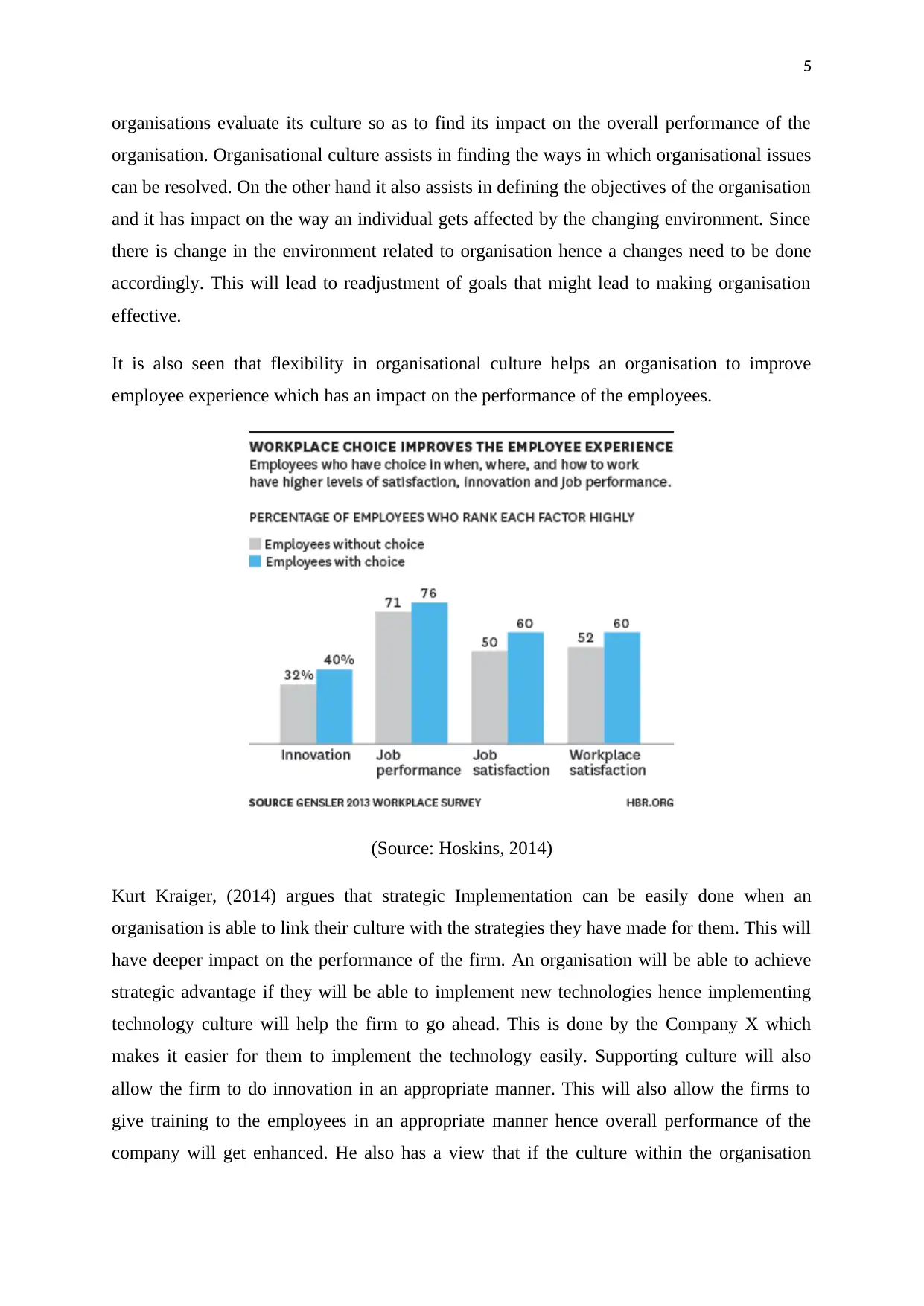
5
organisations evaluate its culture so as to find its impact on the overall performance of the
organisation. Organisational culture assists in finding the ways in which organisational issues
can be resolved. On the other hand it also assists in defining the objectives of the organisation
and it has impact on the way an individual gets affected by the changing environment. Since
there is change in the environment related to organisation hence a changes need to be done
accordingly. This will lead to readjustment of goals that might lead to making organisation
effective.
It is also seen that flexibility in organisational culture helps an organisation to improve
employee experience which has an impact on the performance of the employees.
(Source: Hoskins, 2014)
Kurt Kraiger, (2014) argues that strategic Implementation can be easily done when an
organisation is able to link their culture with the strategies they have made for them. This will
have deeper impact on the performance of the firm. An organisation will be able to achieve
strategic advantage if they will be able to implement new technologies hence implementing
technology culture will help the firm to go ahead. This is done by the Company X which
makes it easier for them to implement the technology easily. Supporting culture will also
allow the firm to do innovation in an appropriate manner. This will also allow the firms to
give training to the employees in an appropriate manner hence overall performance of the
company will get enhanced. He also has a view that if the culture within the organisation
organisations evaluate its culture so as to find its impact on the overall performance of the
organisation. Organisational culture assists in finding the ways in which organisational issues
can be resolved. On the other hand it also assists in defining the objectives of the organisation
and it has impact on the way an individual gets affected by the changing environment. Since
there is change in the environment related to organisation hence a changes need to be done
accordingly. This will lead to readjustment of goals that might lead to making organisation
effective.
It is also seen that flexibility in organisational culture helps an organisation to improve
employee experience which has an impact on the performance of the employees.
(Source: Hoskins, 2014)
Kurt Kraiger, (2014) argues that strategic Implementation can be easily done when an
organisation is able to link their culture with the strategies they have made for them. This will
have deeper impact on the performance of the firm. An organisation will be able to achieve
strategic advantage if they will be able to implement new technologies hence implementing
technology culture will help the firm to go ahead. This is done by the Company X which
makes it easier for them to implement the technology easily. Supporting culture will also
allow the firm to do innovation in an appropriate manner. This will also allow the firms to
give training to the employees in an appropriate manner hence overall performance of the
company will get enhanced. He also has a view that if the culture within the organisation
⊘ This is a preview!⊘
Do you want full access?
Subscribe today to unlock all pages.

Trusted by 1+ million students worldwide
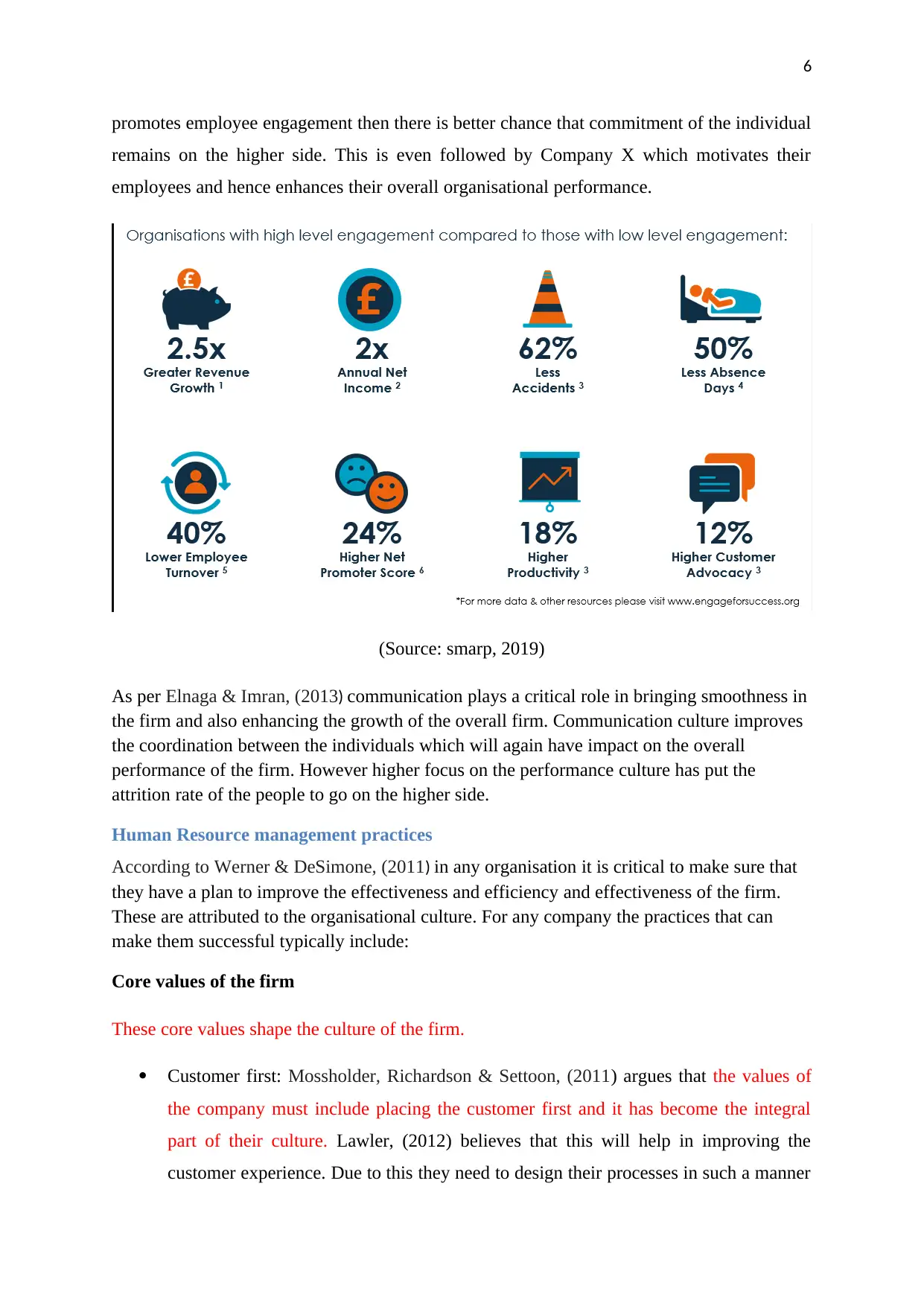
6
promotes employee engagement then there is better chance that commitment of the individual
remains on the higher side. This is even followed by Company X which motivates their
employees and hence enhances their overall organisational performance.
(Source: smarp, 2019)
As per Elnaga & Imran, (2013) communication plays a critical role in bringing smoothness in
the firm and also enhancing the growth of the overall firm. Communication culture improves
the coordination between the individuals which will again have impact on the overall
performance of the firm. However higher focus on the performance culture has put the
attrition rate of the people to go on the higher side.
Human Resource management practices
According to Werner & DeSimone, (2011) in any organisation it is critical to make sure that
they have a plan to improve the effectiveness and efficiency and effectiveness of the firm.
These are attributed to the organisational culture. For any company the practices that can
make them successful typically include:
Core values of the firm
These core values shape the culture of the firm.
Customer first: Mossholder, Richardson & Settoon, (2011) argues that the values of
the company must include placing the customer first and it has become the integral
part of their culture. Lawler, (2012) believes that this will help in improving the
customer experience. Due to this they need to design their processes in such a manner
promotes employee engagement then there is better chance that commitment of the individual
remains on the higher side. This is even followed by Company X which motivates their
employees and hence enhances their overall organisational performance.
(Source: smarp, 2019)
As per Elnaga & Imran, (2013) communication plays a critical role in bringing smoothness in
the firm and also enhancing the growth of the overall firm. Communication culture improves
the coordination between the individuals which will again have impact on the overall
performance of the firm. However higher focus on the performance culture has put the
attrition rate of the people to go on the higher side.
Human Resource management practices
According to Werner & DeSimone, (2011) in any organisation it is critical to make sure that
they have a plan to improve the effectiveness and efficiency and effectiveness of the firm.
These are attributed to the organisational culture. For any company the practices that can
make them successful typically include:
Core values of the firm
These core values shape the culture of the firm.
Customer first: Mossholder, Richardson & Settoon, (2011) argues that the values of
the company must include placing the customer first and it has become the integral
part of their culture. Lawler, (2012) believes that this will help in improving the
customer experience. Due to this they need to design their processes in such a manner
Paraphrase This Document
Need a fresh take? Get an instant paraphrase of this document with our AI Paraphraser
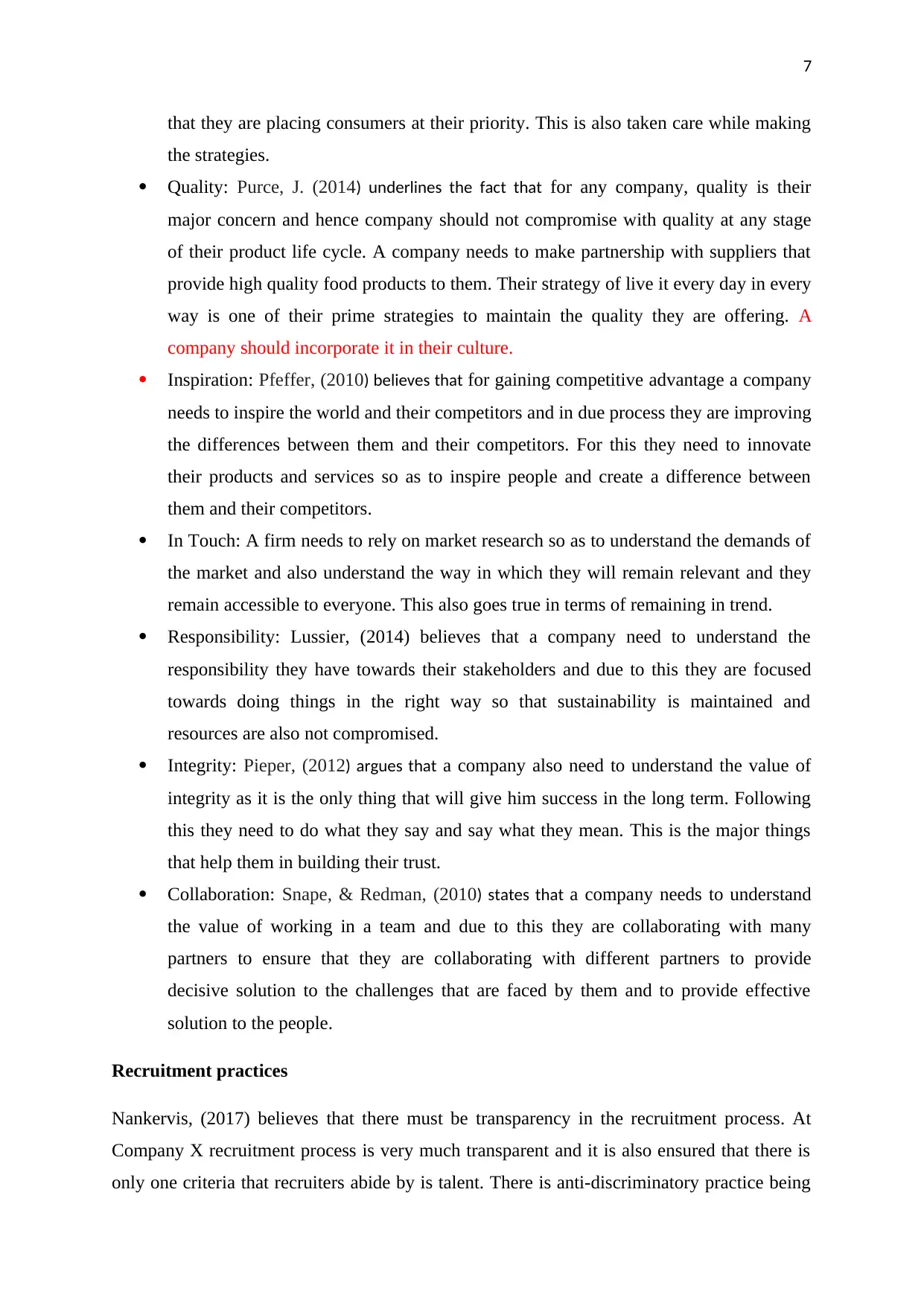
7
that they are placing consumers at their priority. This is also taken care while making
the strategies.
Quality: Purce, J. (2014) underlines the fact that for any company, quality is their
major concern and hence company should not compromise with quality at any stage
of their product life cycle. A company needs to make partnership with suppliers that
provide high quality food products to them. Their strategy of live it every day in every
way is one of their prime strategies to maintain the quality they are offering. A
company should incorporate it in their culture.
Inspiration: Pfeffer, (2010) believes that for gaining competitive advantage a company
needs to inspire the world and their competitors and in due process they are improving
the differences between them and their competitors. For this they need to innovate
their products and services so as to inspire people and create a difference between
them and their competitors.
In Touch: A firm needs to rely on market research so as to understand the demands of
the market and also understand the way in which they will remain relevant and they
remain accessible to everyone. This also goes true in terms of remaining in trend.
Responsibility: Lussier, (2014) believes that a company need to understand the
responsibility they have towards their stakeholders and due to this they are focused
towards doing things in the right way so that sustainability is maintained and
resources are also not compromised.
Integrity: Pieper, (2012) argues that a company also need to understand the value of
integrity as it is the only thing that will give him success in the long term. Following
this they need to do what they say and say what they mean. This is the major things
that help them in building their trust.
Collaboration: Snape, & Redman, (2010) states that a company needs to understand
the value of working in a team and due to this they are collaborating with many
partners to ensure that they are collaborating with different partners to provide
decisive solution to the challenges that are faced by them and to provide effective
solution to the people.
Recruitment practices
Nankervis, (2017) believes that there must be transparency in the recruitment process. At
Company X recruitment process is very much transparent and it is also ensured that there is
only one criteria that recruiters abide by is talent. There is anti-discriminatory practice being
that they are placing consumers at their priority. This is also taken care while making
the strategies.
Quality: Purce, J. (2014) underlines the fact that for any company, quality is their
major concern and hence company should not compromise with quality at any stage
of their product life cycle. A company needs to make partnership with suppliers that
provide high quality food products to them. Their strategy of live it every day in every
way is one of their prime strategies to maintain the quality they are offering. A
company should incorporate it in their culture.
Inspiration: Pfeffer, (2010) believes that for gaining competitive advantage a company
needs to inspire the world and their competitors and in due process they are improving
the differences between them and their competitors. For this they need to innovate
their products and services so as to inspire people and create a difference between
them and their competitors.
In Touch: A firm needs to rely on market research so as to understand the demands of
the market and also understand the way in which they will remain relevant and they
remain accessible to everyone. This also goes true in terms of remaining in trend.
Responsibility: Lussier, (2014) believes that a company need to understand the
responsibility they have towards their stakeholders and due to this they are focused
towards doing things in the right way so that sustainability is maintained and
resources are also not compromised.
Integrity: Pieper, (2012) argues that a company also need to understand the value of
integrity as it is the only thing that will give him success in the long term. Following
this they need to do what they say and say what they mean. This is the major things
that help them in building their trust.
Collaboration: Snape, & Redman, (2010) states that a company needs to understand
the value of working in a team and due to this they are collaborating with many
partners to ensure that they are collaborating with different partners to provide
decisive solution to the challenges that are faced by them and to provide effective
solution to the people.
Recruitment practices
Nankervis, (2017) believes that there must be transparency in the recruitment process. At
Company X recruitment process is very much transparent and it is also ensured that there is
only one criteria that recruiters abide by is talent. There is anti-discriminatory practice being
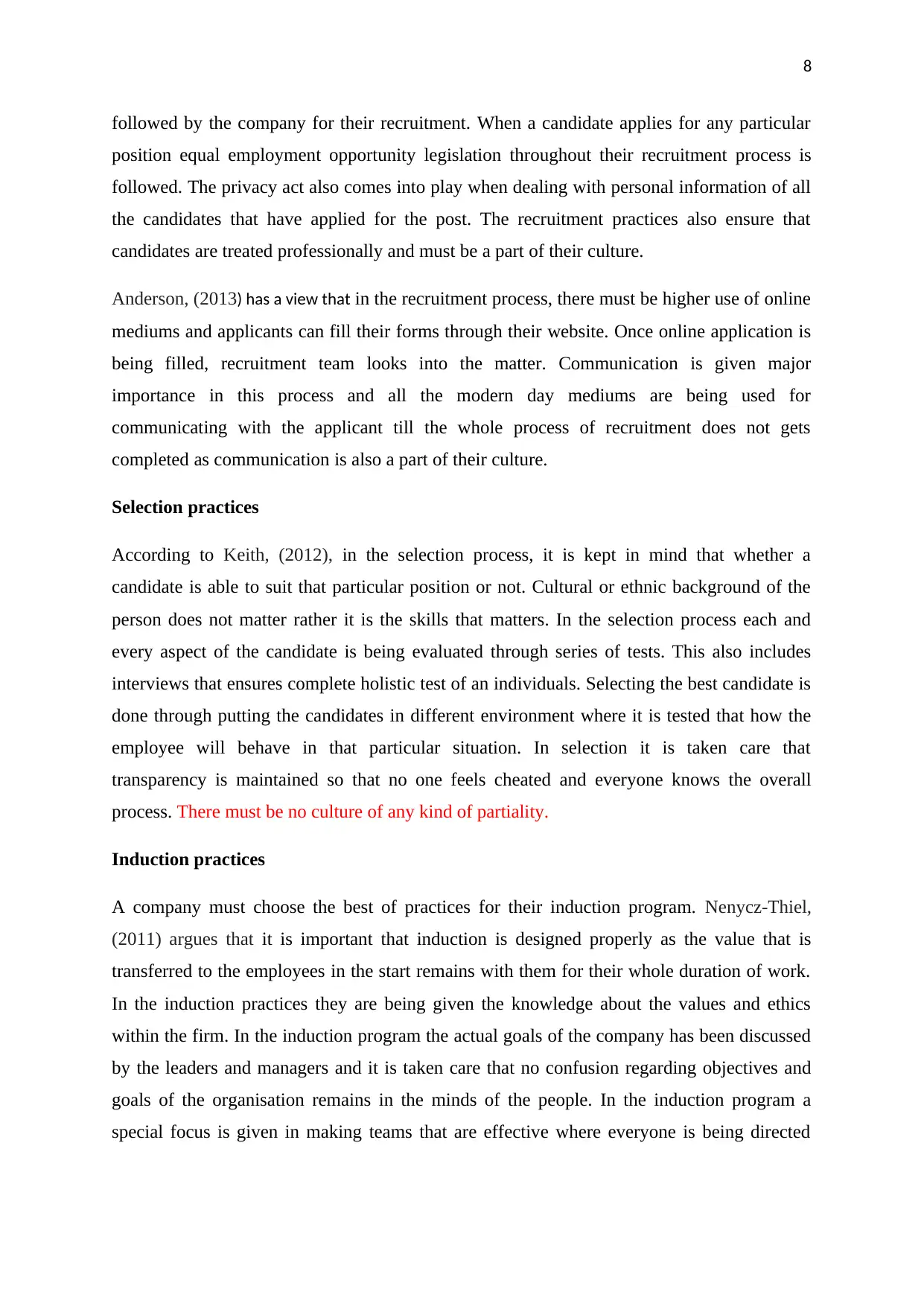
8
followed by the company for their recruitment. When a candidate applies for any particular
position equal employment opportunity legislation throughout their recruitment process is
followed. The privacy act also comes into play when dealing with personal information of all
the candidates that have applied for the post. The recruitment practices also ensure that
candidates are treated professionally and must be a part of their culture.
Anderson, (2013) has a view that in the recruitment process, there must be higher use of online
mediums and applicants can fill their forms through their website. Once online application is
being filled, recruitment team looks into the matter. Communication is given major
importance in this process and all the modern day mediums are being used for
communicating with the applicant till the whole process of recruitment does not gets
completed as communication is also a part of their culture.
Selection practices
According to Keith, (2012), in the selection process, it is kept in mind that whether a
candidate is able to suit that particular position or not. Cultural or ethnic background of the
person does not matter rather it is the skills that matters. In the selection process each and
every aspect of the candidate is being evaluated through series of tests. This also includes
interviews that ensures complete holistic test of an individuals. Selecting the best candidate is
done through putting the candidates in different environment where it is tested that how the
employee will behave in that particular situation. In selection it is taken care that
transparency is maintained so that no one feels cheated and everyone knows the overall
process. There must be no culture of any kind of partiality.
Induction practices
A company must choose the best of practices for their induction program. Nenycz-Thiel,
(2011) argues that it is important that induction is designed properly as the value that is
transferred to the employees in the start remains with them for their whole duration of work.
In the induction practices they are being given the knowledge about the values and ethics
within the firm. In the induction program the actual goals of the company has been discussed
by the leaders and managers and it is taken care that no confusion regarding objectives and
goals of the organisation remains in the minds of the people. In the induction program a
special focus is given in making teams that are effective where everyone is being directed
followed by the company for their recruitment. When a candidate applies for any particular
position equal employment opportunity legislation throughout their recruitment process is
followed. The privacy act also comes into play when dealing with personal information of all
the candidates that have applied for the post. The recruitment practices also ensure that
candidates are treated professionally and must be a part of their culture.
Anderson, (2013) has a view that in the recruitment process, there must be higher use of online
mediums and applicants can fill their forms through their website. Once online application is
being filled, recruitment team looks into the matter. Communication is given major
importance in this process and all the modern day mediums are being used for
communicating with the applicant till the whole process of recruitment does not gets
completed as communication is also a part of their culture.
Selection practices
According to Keith, (2012), in the selection process, it is kept in mind that whether a
candidate is able to suit that particular position or not. Cultural or ethnic background of the
person does not matter rather it is the skills that matters. In the selection process each and
every aspect of the candidate is being evaluated through series of tests. This also includes
interviews that ensures complete holistic test of an individuals. Selecting the best candidate is
done through putting the candidates in different environment where it is tested that how the
employee will behave in that particular situation. In selection it is taken care that
transparency is maintained so that no one feels cheated and everyone knows the overall
process. There must be no culture of any kind of partiality.
Induction practices
A company must choose the best of practices for their induction program. Nenycz-Thiel,
(2011) argues that it is important that induction is designed properly as the value that is
transferred to the employees in the start remains with them for their whole duration of work.
In the induction practices they are being given the knowledge about the values and ethics
within the firm. In the induction program the actual goals of the company has been discussed
by the leaders and managers and it is taken care that no confusion regarding objectives and
goals of the organisation remains in the minds of the people. In the induction program a
special focus is given in making teams that are effective where everyone is being directed
⊘ This is a preview!⊘
Do you want full access?
Subscribe today to unlock all pages.

Trusted by 1+ million students worldwide
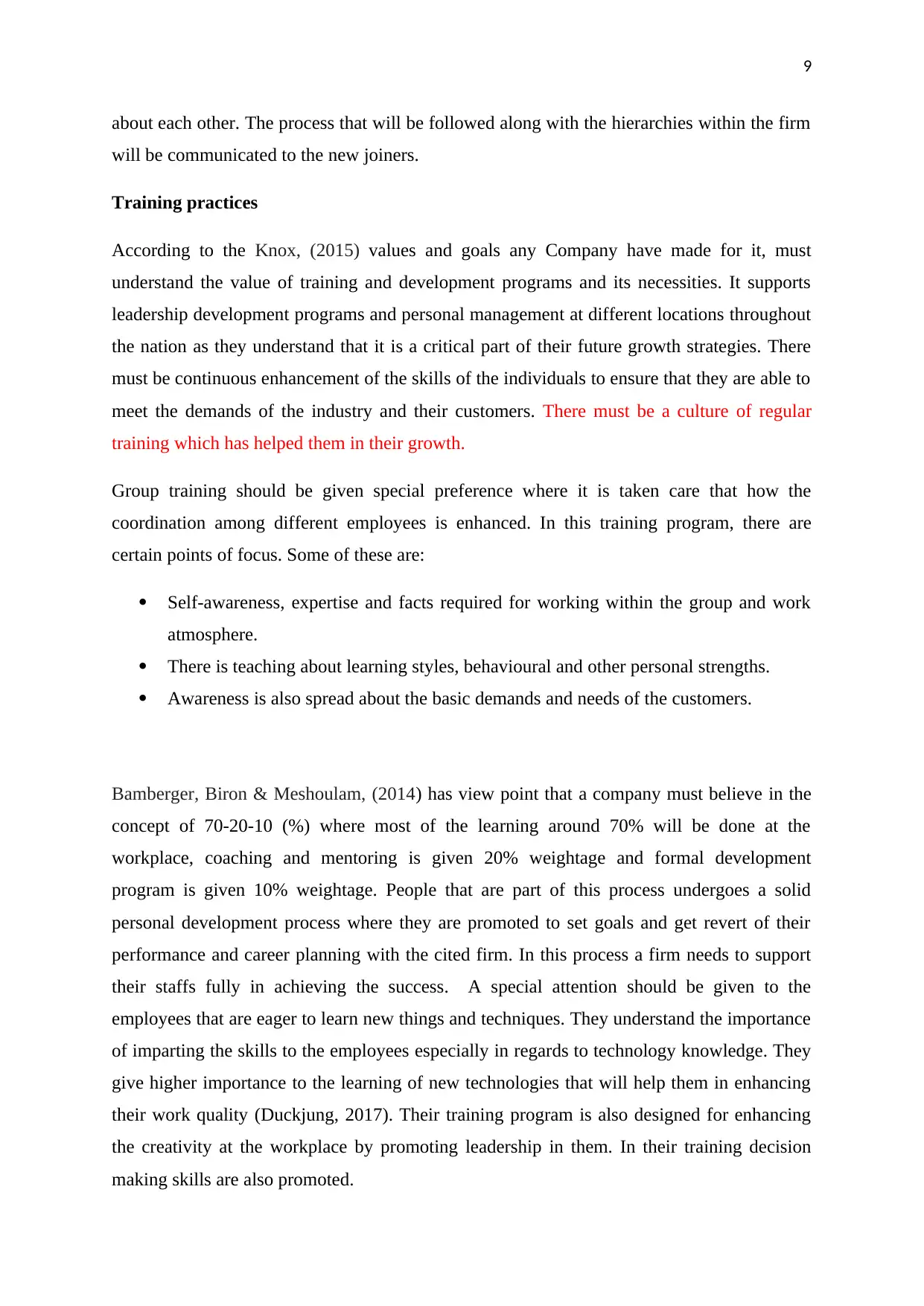
9
about each other. The process that will be followed along with the hierarchies within the firm
will be communicated to the new joiners.
Training practices
According to the Knox, (2015) values and goals any Company have made for it, must
understand the value of training and development programs and its necessities. It supports
leadership development programs and personal management at different locations throughout
the nation as they understand that it is a critical part of their future growth strategies. There
must be continuous enhancement of the skills of the individuals to ensure that they are able to
meet the demands of the industry and their customers. There must be a culture of regular
training which has helped them in their growth.
Group training should be given special preference where it is taken care that how the
coordination among different employees is enhanced. In this training program, there are
certain points of focus. Some of these are:
Self-awareness, expertise and facts required for working within the group and work
atmosphere.
There is teaching about learning styles, behavioural and other personal strengths.
Awareness is also spread about the basic demands and needs of the customers.
Bamberger, Biron & Meshoulam, (2014) has view point that a company must believe in the
concept of 70-20-10 (%) where most of the learning around 70% will be done at the
workplace, coaching and mentoring is given 20% weightage and formal development
program is given 10% weightage. People that are part of this process undergoes a solid
personal development process where they are promoted to set goals and get revert of their
performance and career planning with the cited firm. In this process a firm needs to support
their staffs fully in achieving the success. A special attention should be given to the
employees that are eager to learn new things and techniques. They understand the importance
of imparting the skills to the employees especially in regards to technology knowledge. They
give higher importance to the learning of new technologies that will help them in enhancing
their work quality (Duckjung, 2017). Their training program is also designed for enhancing
the creativity at the workplace by promoting leadership in them. In their training decision
making skills are also promoted.
about each other. The process that will be followed along with the hierarchies within the firm
will be communicated to the new joiners.
Training practices
According to the Knox, (2015) values and goals any Company have made for it, must
understand the value of training and development programs and its necessities. It supports
leadership development programs and personal management at different locations throughout
the nation as they understand that it is a critical part of their future growth strategies. There
must be continuous enhancement of the skills of the individuals to ensure that they are able to
meet the demands of the industry and their customers. There must be a culture of regular
training which has helped them in their growth.
Group training should be given special preference where it is taken care that how the
coordination among different employees is enhanced. In this training program, there are
certain points of focus. Some of these are:
Self-awareness, expertise and facts required for working within the group and work
atmosphere.
There is teaching about learning styles, behavioural and other personal strengths.
Awareness is also spread about the basic demands and needs of the customers.
Bamberger, Biron & Meshoulam, (2014) has view point that a company must believe in the
concept of 70-20-10 (%) where most of the learning around 70% will be done at the
workplace, coaching and mentoring is given 20% weightage and formal development
program is given 10% weightage. People that are part of this process undergoes a solid
personal development process where they are promoted to set goals and get revert of their
performance and career planning with the cited firm. In this process a firm needs to support
their staffs fully in achieving the success. A special attention should be given to the
employees that are eager to learn new things and techniques. They understand the importance
of imparting the skills to the employees especially in regards to technology knowledge. They
give higher importance to the learning of new technologies that will help them in enhancing
their work quality (Duckjung, 2017). Their training program is also designed for enhancing
the creativity at the workplace by promoting leadership in them. In their training decision
making skills are also promoted.
Paraphrase This Document
Need a fresh take? Get an instant paraphrase of this document with our AI Paraphraser
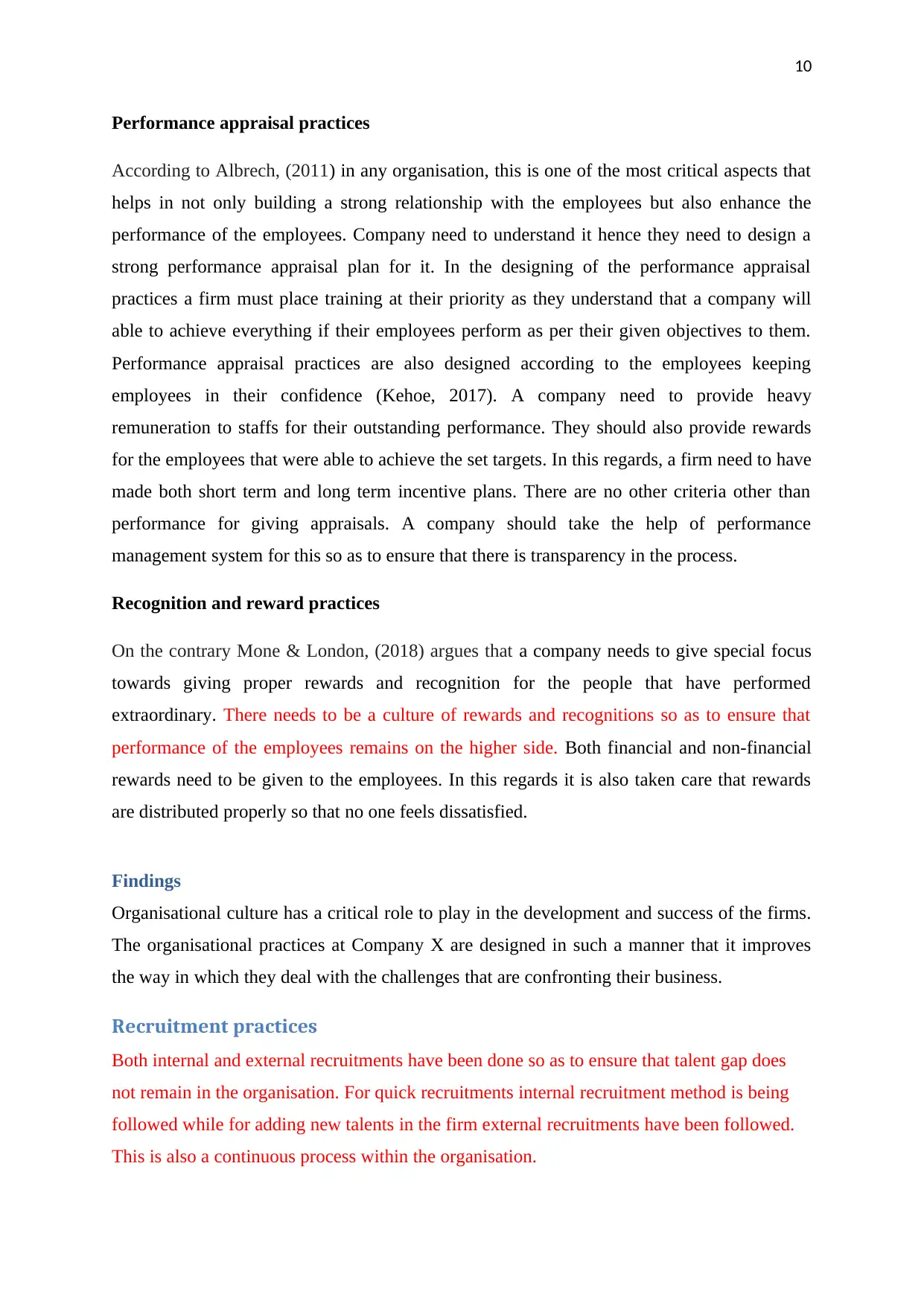
10
Performance appraisal practices
According to Albrech, (2011) in any organisation, this is one of the most critical aspects that
helps in not only building a strong relationship with the employees but also enhance the
performance of the employees. Company need to understand it hence they need to design a
strong performance appraisal plan for it. In the designing of the performance appraisal
practices a firm must place training at their priority as they understand that a company will
able to achieve everything if their employees perform as per their given objectives to them.
Performance appraisal practices are also designed according to the employees keeping
employees in their confidence (Kehoe, 2017). A company need to provide heavy
remuneration to staffs for their outstanding performance. They should also provide rewards
for the employees that were able to achieve the set targets. In this regards, a firm need to have
made both short term and long term incentive plans. There are no other criteria other than
performance for giving appraisals. A company should take the help of performance
management system for this so as to ensure that there is transparency in the process.
Recognition and reward practices
On the contrary Mone & London, (2018) argues that a company needs to give special focus
towards giving proper rewards and recognition for the people that have performed
extraordinary. There needs to be a culture of rewards and recognitions so as to ensure that
performance of the employees remains on the higher side. Both financial and non-financial
rewards need to be given to the employees. In this regards it is also taken care that rewards
are distributed properly so that no one feels dissatisfied.
Findings
Organisational culture has a critical role to play in the development and success of the firms.
The organisational practices at Company X are designed in such a manner that it improves
the way in which they deal with the challenges that are confronting their business.
Recruitment practices
Both internal and external recruitments have been done so as to ensure that talent gap does
not remain in the organisation. For quick recruitments internal recruitment method is being
followed while for adding new talents in the firm external recruitments have been followed.
This is also a continuous process within the organisation.
Performance appraisal practices
According to Albrech, (2011) in any organisation, this is one of the most critical aspects that
helps in not only building a strong relationship with the employees but also enhance the
performance of the employees. Company need to understand it hence they need to design a
strong performance appraisal plan for it. In the designing of the performance appraisal
practices a firm must place training at their priority as they understand that a company will
able to achieve everything if their employees perform as per their given objectives to them.
Performance appraisal practices are also designed according to the employees keeping
employees in their confidence (Kehoe, 2017). A company need to provide heavy
remuneration to staffs for their outstanding performance. They should also provide rewards
for the employees that were able to achieve the set targets. In this regards, a firm need to have
made both short term and long term incentive plans. There are no other criteria other than
performance for giving appraisals. A company should take the help of performance
management system for this so as to ensure that there is transparency in the process.
Recognition and reward practices
On the contrary Mone & London, (2018) argues that a company needs to give special focus
towards giving proper rewards and recognition for the people that have performed
extraordinary. There needs to be a culture of rewards and recognitions so as to ensure that
performance of the employees remains on the higher side. Both financial and non-financial
rewards need to be given to the employees. In this regards it is also taken care that rewards
are distributed properly so that no one feels dissatisfied.
Findings
Organisational culture has a critical role to play in the development and success of the firms.
The organisational practices at Company X are designed in such a manner that it improves
the way in which they deal with the challenges that are confronting their business.
Recruitment practices
Both internal and external recruitments have been done so as to ensure that talent gap does
not remain in the organisation. For quick recruitments internal recruitment method is being
followed while for adding new talents in the firm external recruitments have been followed.
This is also a continuous process within the organisation.
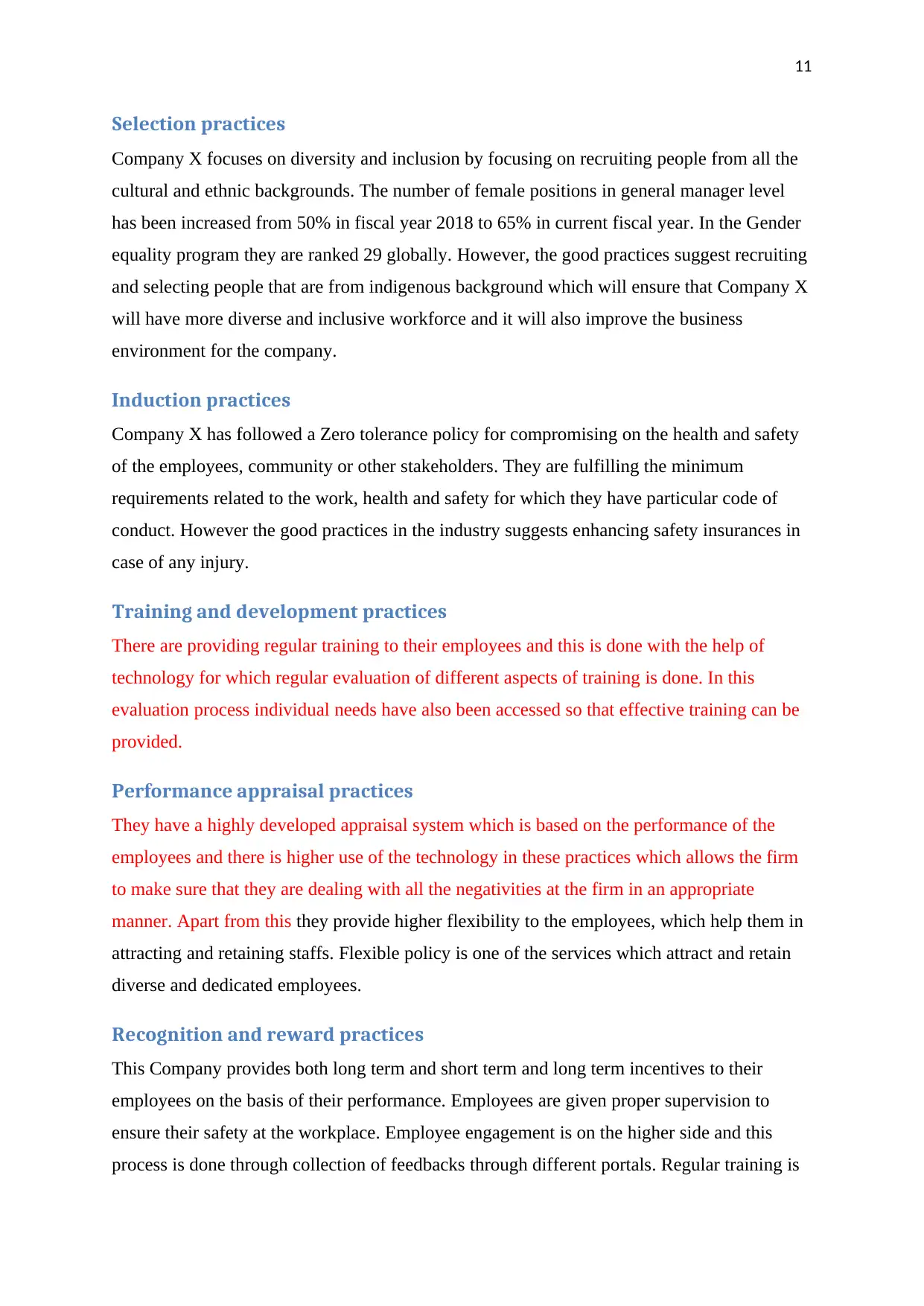
11
Selection practices
Company X focuses on diversity and inclusion by focusing on recruiting people from all the
cultural and ethnic backgrounds. The number of female positions in general manager level
has been increased from 50% in fiscal year 2018 to 65% in current fiscal year. In the Gender
equality program they are ranked 29 globally. However, the good practices suggest recruiting
and selecting people that are from indigenous background which will ensure that Company X
will have more diverse and inclusive workforce and it will also improve the business
environment for the company.
Induction practices
Company X has followed a Zero tolerance policy for compromising on the health and safety
of the employees, community or other stakeholders. They are fulfilling the minimum
requirements related to the work, health and safety for which they have particular code of
conduct. However the good practices in the industry suggests enhancing safety insurances in
case of any injury.
Training and development practices
There are providing regular training to their employees and this is done with the help of
technology for which regular evaluation of different aspects of training is done. In this
evaluation process individual needs have also been accessed so that effective training can be
provided.
Performance appraisal practices
They have a highly developed appraisal system which is based on the performance of the
employees and there is higher use of the technology in these practices which allows the firm
to make sure that they are dealing with all the negativities at the firm in an appropriate
manner. Apart from this they provide higher flexibility to the employees, which help them in
attracting and retaining staffs. Flexible policy is one of the services which attract and retain
diverse and dedicated employees.
Recognition and reward practices
This Company provides both long term and short term and long term incentives to their
employees on the basis of their performance. Employees are given proper supervision to
ensure their safety at the workplace. Employee engagement is on the higher side and this
process is done through collection of feedbacks through different portals. Regular training is
Selection practices
Company X focuses on diversity and inclusion by focusing on recruiting people from all the
cultural and ethnic backgrounds. The number of female positions in general manager level
has been increased from 50% in fiscal year 2018 to 65% in current fiscal year. In the Gender
equality program they are ranked 29 globally. However, the good practices suggest recruiting
and selecting people that are from indigenous background which will ensure that Company X
will have more diverse and inclusive workforce and it will also improve the business
environment for the company.
Induction practices
Company X has followed a Zero tolerance policy for compromising on the health and safety
of the employees, community or other stakeholders. They are fulfilling the minimum
requirements related to the work, health and safety for which they have particular code of
conduct. However the good practices in the industry suggests enhancing safety insurances in
case of any injury.
Training and development practices
There are providing regular training to their employees and this is done with the help of
technology for which regular evaluation of different aspects of training is done. In this
evaluation process individual needs have also been accessed so that effective training can be
provided.
Performance appraisal practices
They have a highly developed appraisal system which is based on the performance of the
employees and there is higher use of the technology in these practices which allows the firm
to make sure that they are dealing with all the negativities at the firm in an appropriate
manner. Apart from this they provide higher flexibility to the employees, which help them in
attracting and retaining staffs. Flexible policy is one of the services which attract and retain
diverse and dedicated employees.
Recognition and reward practices
This Company provides both long term and short term and long term incentives to their
employees on the basis of their performance. Employees are given proper supervision to
ensure their safety at the workplace. Employee engagement is on the higher side and this
process is done through collection of feedbacks through different portals. Regular training is
⊘ This is a preview!⊘
Do you want full access?
Subscribe today to unlock all pages.

Trusted by 1+ million students worldwide
1 out of 17
Related Documents
Your All-in-One AI-Powered Toolkit for Academic Success.
+13062052269
info@desklib.com
Available 24*7 on WhatsApp / Email
![[object Object]](/_next/static/media/star-bottom.7253800d.svg)
Unlock your academic potential
Copyright © 2020–2025 A2Z Services. All Rights Reserved. Developed and managed by ZUCOL.




